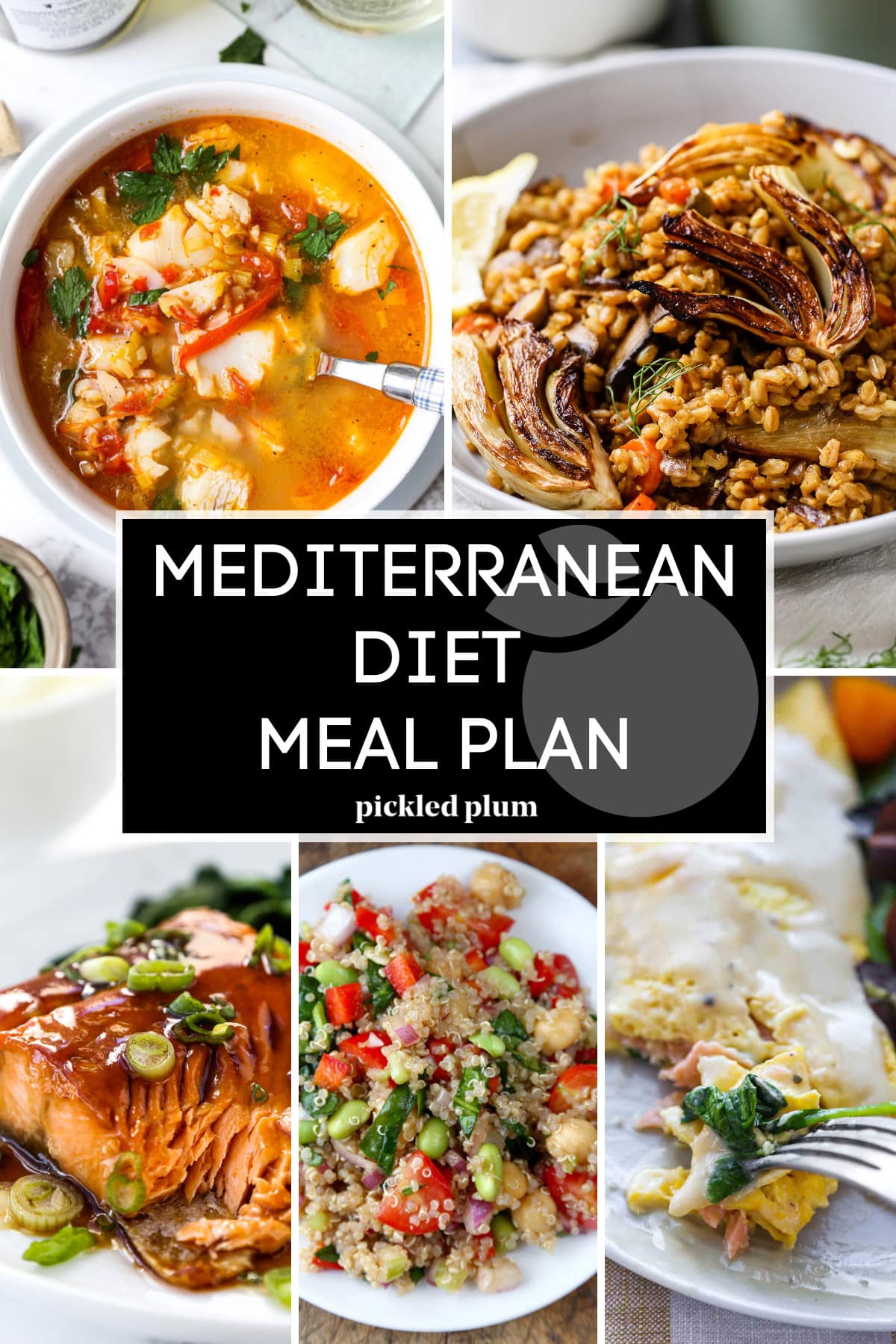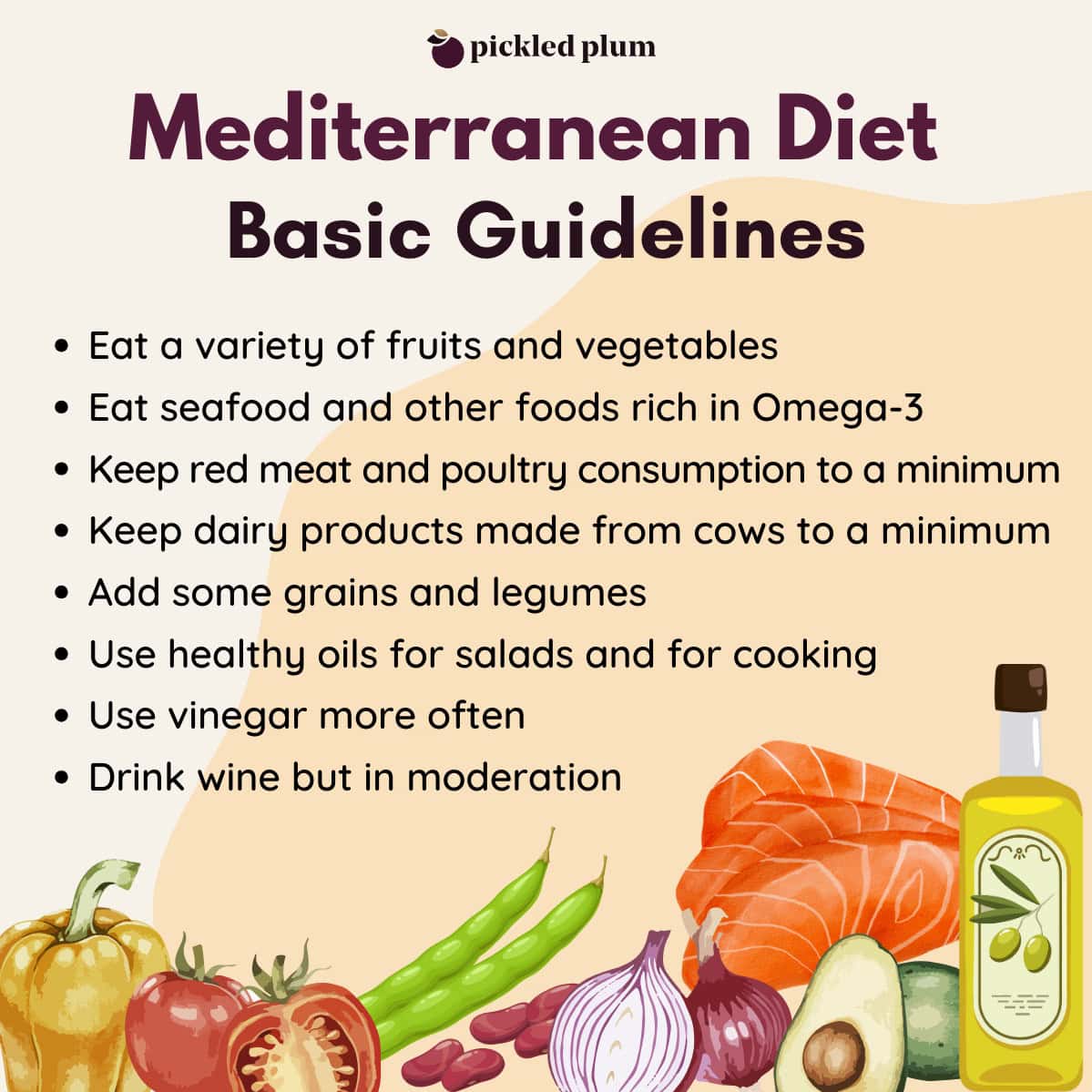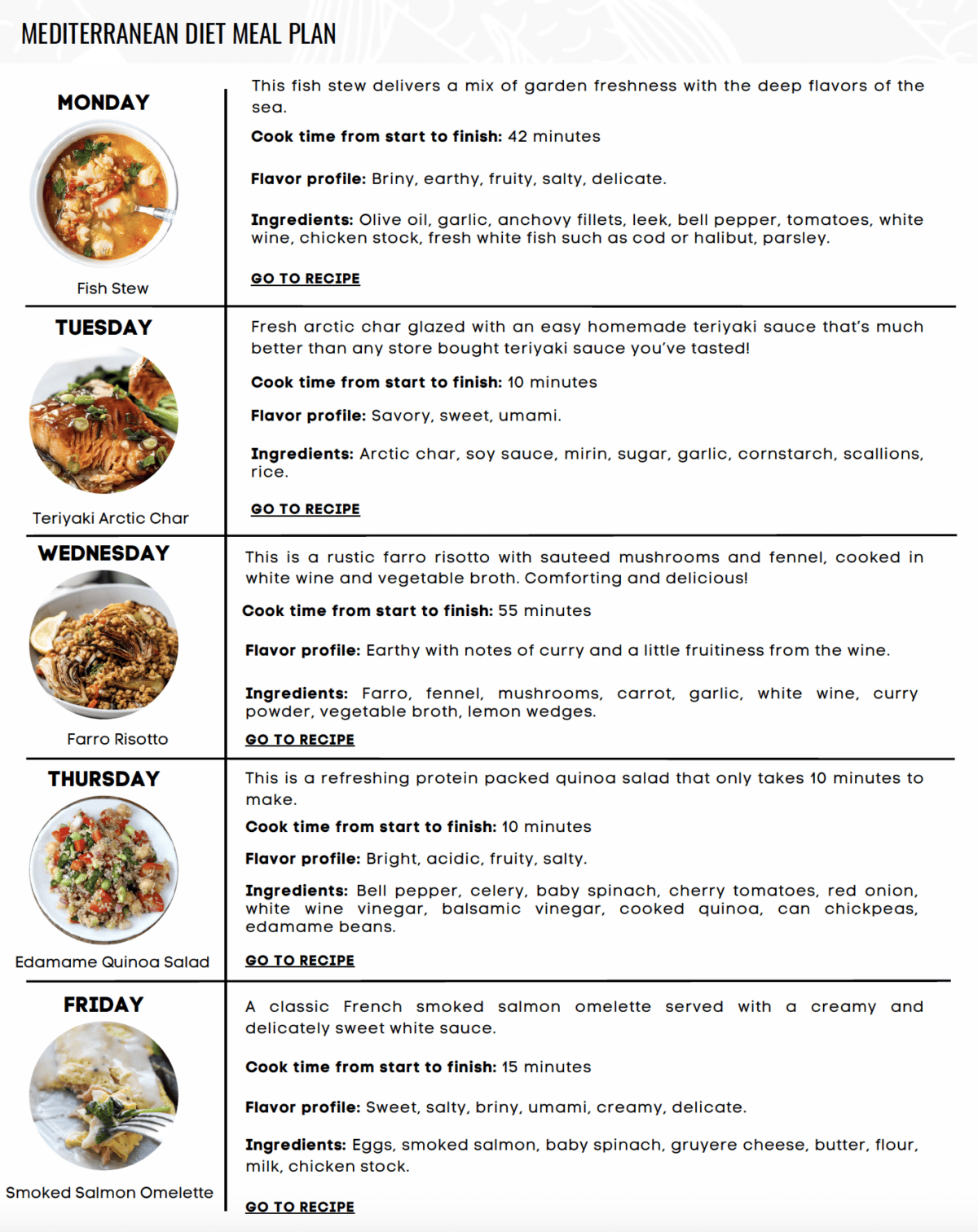This week’s menu focuses on ingredients commonly used in the Mediterranean diet. I have also included some Asian recipes that fit the Mediterranean diet plan to diversify the menu and keep it fun. This week on the menu – a comforting fish stew, a hearty farro, mushroom, and fennel risotto, a moist and tender teriyaki arctic char, a bright and cleansing quinoa salad, and a creamy and fluffy smoked salmon omelet.

Benefits of Meal Planning
Meal planning offers a multitude of benefits that can make cooking more enjoyable, especially when you have a busy week coming up. Incorporating meal planning into your cooking routine not only simplifies the process but also contributes to healthier eating habits, financial savings, and a more enjoyable overall cooking experience. Let’s take a look at some of the benefits:
Time-Saving: Meal planning saves time during the week. When you already know what you’re cooking, you can streamline your grocery shopping and meal preparation.
Reduces Food Waste: By planning your meals, you buy only what you need and use ingredients efficiently, reducing food waste and saving money.
Healthier Choices: Meal planning encourages thoughtful menu choices. It allows you to incorporate a variety of nutritious ingredients and take out some that are not so healthy.
Budget-Friendly and Reduced Last Minute Decisions: It helps you stick to your budget by avoiding impulse purchases and dining out. With a meal plan in place, you won’t resort to unhealthy takeout or fast food when you’re too tired to decide what to cook.
Less Stress: Knowing what you’re going to cook each day reduces stress in the kitchen. You can also plan easy, quick meals for busy days, or make a few dishes ahead of time that you can freeze and enjoy later.
Diverse Menu: Meal planning allows you to experiment with different cuisines, expanding your culinary horizons and keeping mealtime fun and interesting.
Portion Control: You can portion meals appropriately, reducing the chances of overeating.
Customization: Tailor your meals to dietary preferences or restrictions, ensuring that everyone in your household is taken care of.
Eco-Friendly: Reducing food waste and choosing local, seasonal ingredients as part of your meal plan can have a positive impact on the environment.
What Is The Mediterranean Diet?
Firstly, the Mediterranean diet isn’t an actual diet. It is based on the daily eating habits of people living by the Mediterranean Sea, which include countries like Greece, Spain, and Italy. The concept is quite simple: there are no specific rules to follow other than to mostly focus on eating healthy fats and keeping the consumption of meat, dairy, and processed foods to a minimum. It’s a mostly plant based way of eating that still leaves room for plenty of enjoyment.
That’s it! There is no need to keep track of calories or fat content since the foods recommended are mostly packed with healthy fats and are also low in calories.
The Complete Digital Meal Planner
Stay organized with The Complete Digital Meal Planner. Create a weekly meal schedule, plan meals, save your favorite recipes, and shop smarter. Reduce stress and enjoy delicious meals with this easy-to-use meal planner. It’s meal planning made simple!
Mediterranean Diet Food List
As an addition to the Mediterranean diet meal plan, I have included a list of popular foods and ingredients to include into your day to day meals, should you want to transition to this way of eating. I personally follow a mix of both Mediterranean diet and old school Japanese diet (Okinawa). Since they can be quite similar, it’s easy to mix them up and keep things more fun and interesting in the kitchen!
- Eat a variety of fruits and vegetables. Think of bright colors such as sweet potatoes, Okinawa purple sweet potatoes, eggplant, leafy greens, bell peppers, red onions, spinach, avocados, beets, and artichokes. Citrus fruits such as lemons, grapefruit, clementines, and oranges, are a very important part of the Mediterranean diet. Other popular fruit to include are cherries, tomatoes, olives, dates, figs, apricots, peaches, pears, apples, strawberries, and melons.
- Eat seafood and other foods rich in Omega-3. Adding fish (salmon, trout, sardines, anchovies) nuts (pecans, walnuts, pistachios, almonds) and seeds (flax, chia, hemp, sesame) to your diet, 2 to 3 times a week, is recommended.
- Keep red meat and poultry consumption to a minimum. When I say to a minimum, it means both in frequency and quantity. If you prefer your steak to be served big like a tomahawk, only once or twice a month should be your guideline. Smaller quantities means you can eat meat and poultry a few times a week, but you will have to keep the amount in check. A piece of chicken or beef should never take more than a quarter of your plate, and if you make a soup or a stew, vegetables and legumes should be in abundance, while meat and poultry should be more of an afterthought, something that adds more flavor.
- Keep dairy products made from cows to a minimum. Instead, pick dairy product made from sheep or goat milk such as feta cheese, old fashioned Greek yogurt (if you are in the US, make sure to look at the label, as most Greek yogurt are made from cow’s milk), ricotta cheese, or haloumi cheese (which can also be made with cow’s milk so take a peek at the label before purchasing it).
- Add some grains and legumes. Lentils, chickpeas, white beans, black beans, any type of bean will do! Beans are filling, low in calories, and packed with fiber and other essential nutrients. As for grains, there are also plenty of options to choose from: quinoa, barley, buckwheat, oats, bulgur wheat, farro, and wild rice, are just a few.
- Use healthy oils for salads and for cooking. The obvious favorite being extra virgin olive oil. Just make sure it’s not overly processed since it affects the quality of the oil. If you are unsure of the quality, look for cold pressed olive oil such as California Olive Ranch Cold Pressed. This type of oil is made by pressing instead of being extracted. Other healthy oils to consider are avocado oil, sesame oil, and safflower oil.
- Vinegar is an important ingredient. People who live near the Mediterranean Sea use vinegar in abundance to season fresh seafood and vegetables. Vinegar is good for you because it contains polyphenols which are plant chemicals that may aid in lowering cholesterol, prevent cancer, and help with digestion.
- Drink wine but in moderation. People from the Mediterranean region are known for their delicious wines. Not only are the wines delicious, they are an essential part of their culture and represent relaxation and celebration. But what’s important to know is that wine is consumed moderately, unlike what we are used to here in the west, when happy hour is in full swing. No more than a glass or two should be consumed in one sitting, and a few days apart if you do it more than once a week. Red one is recommended but the healthiest wine is Ikarian wine because it is completely naturally processed and contains very high levels of antioxidants.

Mediterranean Diet Meal Plan
Every week I will be providing a meal plan in pdf format that you can print or save on an electronic device. Each meal plan will include 5 main dishes with their individual total cooking time and flavor profile, a grocery shopping list, and a link to those recipes. The plan also includes lunch, side, and snack ideas for the week.
This Week’s Menu
Monday:
Fish Stew – This fish stew is light yet very comforting. Colorful ingredients such as a leek, red bell pepper, flat leaf parsley, and freshly chopped tomatoes are used. The simple broth is made with white wine, chicken stock, garlic, and anchovy fillets. Halibut, cod, or sea bass, make the main protein of this dish. It’s one of my favorite winter meals!
Tuesday:
Teriyaki Arctic Char – I love using arctic char because it tastes like a mix of salmon and trout, and is also considered to be a sustainable fish. The texture is firm like salmon as well so it doesn’t flake easily. The teriyaki sauce is homemade, much less sweet than the store bought version (also more yummy), and only requires 5 ingredients to make.
Wednesday:
Mushroom and Fennel Farro Risotto – This rustic risotto is made with whole grain farro and cooked with a little white wine, curry powder, garlic, a mix of earthy shiitake and button mushrooms, and sweet fennel. It’s the ultimate healthy and filling winter food!
Thursday:
Edamame Quinoa Salad – This hearty, protein-packed quinoa salad is not only colorful and nutritious, it’s also refreshing and filling enough to enjoy as a main.
Friday:
Smoked Salmon Omelet With White Sauce – 15 minutes is all it takes to make this beautiful classic French dish. This omelet comes stuffed with salty smoked salmon, baby spinach, and rich and nutty gruyere cheese, and is topped with a creamy, mildly sweet and salty white sauce.

DOWNLOAD THE MEAL PLAN
Prepping Ingredients Ahead of Time (How to Meal-Prep)
Doing a little prep before the work week begins is always a great way to save time in the kitchen after a long day. I do mine on Sundays while listening to my favorites tunes or putting on one of my favorite reality tv shows (a guilty pleasure). This way cooking doesn’t feel like work but more like a relaxing meditation.
Here is how I do my own prep at home:
- I make a list of all the vegetables that need chopping and do as much chopping ahead of time. Especially garlic and onions since many of my recipes use them and they are my least favorite ingredients to chop. I save them separately in storage containers and arrange them neatly in my fridge.
- My husband and I prep all of our morning green juice ingredients and save them in storage containers. This way we can grab a container, dump it in the blender and add water and juice. Quick, easy, and healthy!
- I always have a container of cooked brown rice in the fridge since we eat it so frequently.
- I make salad dressings and stir fry sauces ahead of time, even if they are very simple and quick to make. I never buy store bought since they contain too much sugar and are generally unhealthy.
- Once every other week I make a pot of soup and tell myself there cannot be any leftovers. This forces me to eat healthier and it also saves me time and money (making soup is cheap!).
- I have a weekly menu I refer to so I don’t forget about ingredients that need to be thawed or purchased at the grocery store.
- Speaking of groceries, I like to do mine on a Tuesday or a Wednesday so I can get the freshest ingredients.
Tips For Successful Meal Planning
- Prep your least favorite part of the meal ahead of time. If it’s chopping onion like it is for me, do it ahead so it doesn’t deter you from cooking dinner. If it’s boiling eggs, boil them ahead for the same reason.
- Pay attention to what makes you not want to cook or what makes you say “let’s just order takeout”. Is it a specific part of cooking – chopping onions, having to cook rice, etc… – or is it simply because you are too exhausted? Say you already have cooked rice and prepped veggies in your fridge and all you had to do was cook a protein and saute some veggies, would you still avoid cooking or would the process look more appealing?
- Keep an inventory of what’s about to go bad in your fridge and freezer. This will save you a ton of money! Make two inventory lists: one for the fridge and one for the freezer. The ingredients that are about to expire should be placed at the front of your fridge and freezer – just like grocery stores do! – so they can be used as soon as possible.
- Try to do to keep your visits to the grocery store to a minimum. Once you have your meal plan for the week ready, make a grocery list of all the ingredients you need. This way you greatly minimize trips to the grocery store (I only need to go once or twice per week).
- Keep your kitchen clean. This is so important! My husband hated cooking until I showed him that keeping his work area and kitchen sink clean made the world a difference. It creates less chaos around you which in turn creates less chaos in your head. It’s also very easy to keep your counters clean – as soon as you are done using a pot, plate, or bowl, wash it! This way your kitchen sink will remain empty and you won’t feel overwhelmed by the amount of cleaning left to do once you are done cooking. I learned that trick by working in professional kitchens. This is the only way restaurant kitchens can function successfully – by being as tidy as possible.














